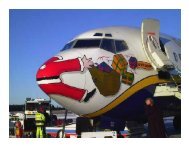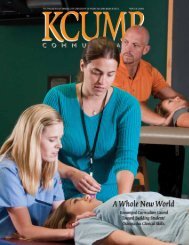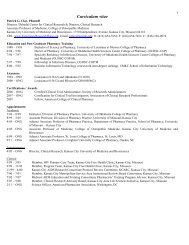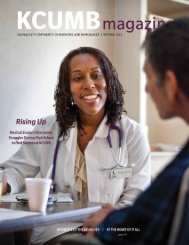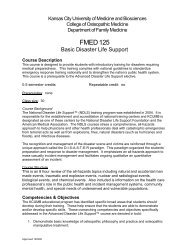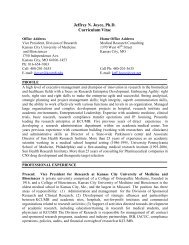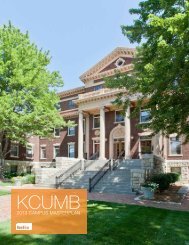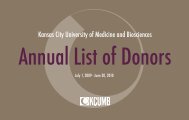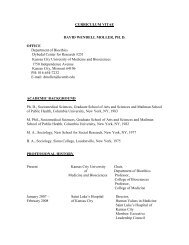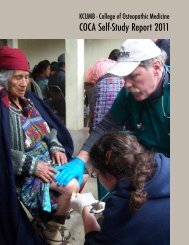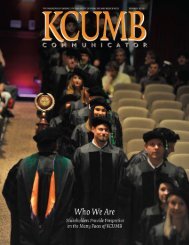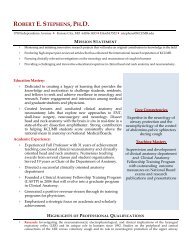news - Kansas City University of Medicine and Biosciences
news - Kansas City University of Medicine and Biosciences
news - Kansas City University of Medicine and Biosciences
- No tags were found...
Create successful ePaper yourself
Turn your PDF publications into a flip-book with our unique Google optimized e-Paper software.
students are able to meetthe donors’ families – amoving <strong>and</strong> meaningfulexperience for everyoneinvolved.“That was so welldone,” said Ray Makalous,referring to the memorialservice. “Getting a chanceto see the students whohad been in the classeswas so comforting. Theyactually put your familymember’s picture up.”For her part, KaraHessel, an osteopathicmedical student, seesthe memorial service asa deeply humanizingmoment.“When you meet thefamily, you see someonewho cared about theperson, <strong>and</strong> you decideyou need to be mindful<strong>of</strong> who this person was,”she said.Hessel, who plansto become a surgeon, istaking a year between her second <strong>and</strong> third years <strong>of</strong> medicalschool to serve as an anatomy fellow. As a fellow, she helpsteach anatomy, works further with the bodies <strong>and</strong> conductsher own research. She firmly believes she owes donors agreat debt <strong>of</strong> gratitude.“I really appreciate everything the donors have done forus,” she said “They have given us the opportunity to learn,<strong>and</strong> to me there is nothing better in life. If what the donorshave done allows me to save other lives, I can’t think <strong>of</strong> anygreater gift.“I wish I could thank each family <strong>and</strong> each person.”The Best Way to LearnThe Gift Body Program at KCUMB depends entirelyon donations. The <strong>University</strong> does not purchase bodies orbody parts for study. It might be easier to rely on anatomicaldummies, textbooks <strong>and</strong> new computer programs to teachanatomy, but in the opinion <strong>of</strong> both program administrators<strong>and</strong> students, the change would remove critical elements <strong>of</strong>the experience.It’s kind <strong>of</strong> like solving a puzzle. Why is there cancer in thislobe <strong>of</strong> the lung <strong>and</strong> not this lobe? Maybe we’ll find a musclethat’s completely undocumented <strong>and</strong> we’ll ask, ‘I wonder ifthis muscle caused them any problem.’ It’s like detective work.Pam Thomas, Ph.D.Speaking from astudent’s perspective,Hessel said, “I knowthere are computerprograms that allowstudents to see things in3D, but it’s not the sameexperience because Ican’t physically touchthat. I don’t know whatthat artery or nerve feelslike.”Dr. Thomas agreesthat adding the sense <strong>of</strong>touch to an anatomy lessonenhances learning.“There are thingsyou just can’t depict ina picture, like a layer <strong>of</strong>tissue in the abdomen.It’s like nothing else,”she said.Gift bodies also addan element <strong>of</strong> diversityto gross anatomy. Theydemonstrate in ways thatanatomical dummies –much less textbooks <strong>and</strong>computer programs –cannot do, that people are different from each other.The first person Dr. Thomas worked on had greenbeans in his lungs, probably as a result <strong>of</strong> aspiration duringa heart attack.“There’s always surprises,” she said. “There are alwaysthings you wouldn’t think about.”The differences <strong>and</strong> surprises that gift bodies presentteach anatomy in ways no other method can. This is one reasonthe KCUMB program does not shy away from acceptingdonors who have died <strong>of</strong> cancer. Not all programs do. Theonly gift body restriction KCUMB has in place is that donorsmust be over 18 years old.“It’s really important for students to see that,” Dr. Thomassaid. “I think they need to see how invasive cancer is. Theyneed to see why it’s important to catch it early.”Dr. Thomas views the gross anatomy lab as a place <strong>of</strong>exploration.“It’s kind <strong>of</strong> like solving a puzzle,” she said. “Whyis there cancer in this lobe <strong>of</strong> the lung <strong>and</strong> not this lobe?Maybe we’ll find a muscle that’s completely undocumented<strong>and</strong> we’ll ask, ‘I wonder if this muscle caused them anyproblem.’ It’s like detective work.”Making Better PhysiciansThe so-called “detective work” is an aspect <strong>of</strong> herexperience in the anatomy lab that is particularly significantto Kara Hessel. By earning an anatomy fellowship, she hasgiven herself an advantage in a highly competitive pr<strong>of</strong>ession.“It’s a great opportunity because I want to go into surgery,<strong>and</strong> it gave me something to talk about during interviews,”she said. “It also gave me the opportunity to do research <strong>and</strong>really learn my anatomy so I can go out <strong>and</strong> do surgery.”Hessel is also interested in teaching, <strong>and</strong> she has achance to hone her skills. Further, she is able to do originalresearch for publication, something that could be a requirementduring her residency.“We have to submit for publication one research study,”she said. “We design the study. We do the majority <strong>of</strong> datacollection. We do the majority <strong>of</strong> data analysis.”Faculty members might help out when they are needed,but students in the anatomy fellowship program are mostlyon their own.For Hessel, doing medical study in the anatomy lab<strong>and</strong> serving as an anatomyfellow means she will be abetter surgeon later on. Shebelieves she will not onlybe more comfortable <strong>and</strong>competent doing proceduresbut also more comfortabletalking with the families <strong>of</strong>people she has treated.A Focus on Caring<strong>and</strong> RespectConversations about theanatomy lab always seemto come back to how muchboth staff <strong>and</strong> students havelearned about living peoplefrom the bodies they havestudied. To Hessel, it is a matter<strong>of</strong> being both sensitized<strong>and</strong> desensitized, but in bothcases in a positive way.“There’s always thethought that someone hasgiven their body so that otherpeople can live,” she said.Dr. Thomas added, “It’skind <strong>of</strong> a mix <strong>of</strong> steelingyourself to the dissection <strong>and</strong>learning from it <strong>and</strong>, at theI know there are computer programs that allow studentsto see things in 3D, but it’s not the same experiencebecause I can’t physically touch that. I don’t know whatthat artery or nerve feels like.same time, remembering that this is a human person.”Not so long ago, bodies were turned over for dissectionas a form a punishment. Today, being a gift body donor issimply a way <strong>of</strong> giving back.Felicia Harris has worked with donors who have contactedher long before they died to make the arrangements.Other donors have told their relatives about their wishesjust before passing away. Still others become part <strong>of</strong> theGift Body Program because a close relative or someone withpower <strong>of</strong> attorney has arranged for the donation.There is only one real challenge to making the donation:time. The body must undergo proper preservation within 24hours <strong>of</strong> death, so transportation is critical. The Gift BodyProgram will pay for transportation <strong>of</strong> bodies within theGreater <strong>Kansas</strong> <strong>City</strong> area.Gift bodies are normally kept at KCUMB for medicalstudy for about a year. At the end <strong>of</strong> that time, the remainsare cremated <strong>and</strong> returned to the family, if requested. Otherwise,they are interred in a local cemetery.Ray Makalous does not have much to say about thepaperwork or transportationor the other details <strong>of</strong> hisKara Hesselmother’s donation. Whathe remembers is the humanside <strong>of</strong> the transaction.“Having Dr. Pam, whohad met my mother, <strong>and</strong>knowing how much she wastied into teaching anatomy<strong>and</strong> how she did such a greatjob <strong>of</strong> being willing to takethe phone calls <strong>and</strong> makesure everything was h<strong>and</strong>ledin the correct way – it was verymeaningful,” he said. “I wouldencourage anyone to attendthe memorial service.”Make an impact. Honor thosewho have donated their bodiesto medical science by supportingthe Anatomical Donor Fund.Look for the envelope inside thismagazine for more details!10 Summer 2012 KCUMB CommunicatorSummer 2012 KCUMB Communicator 11



